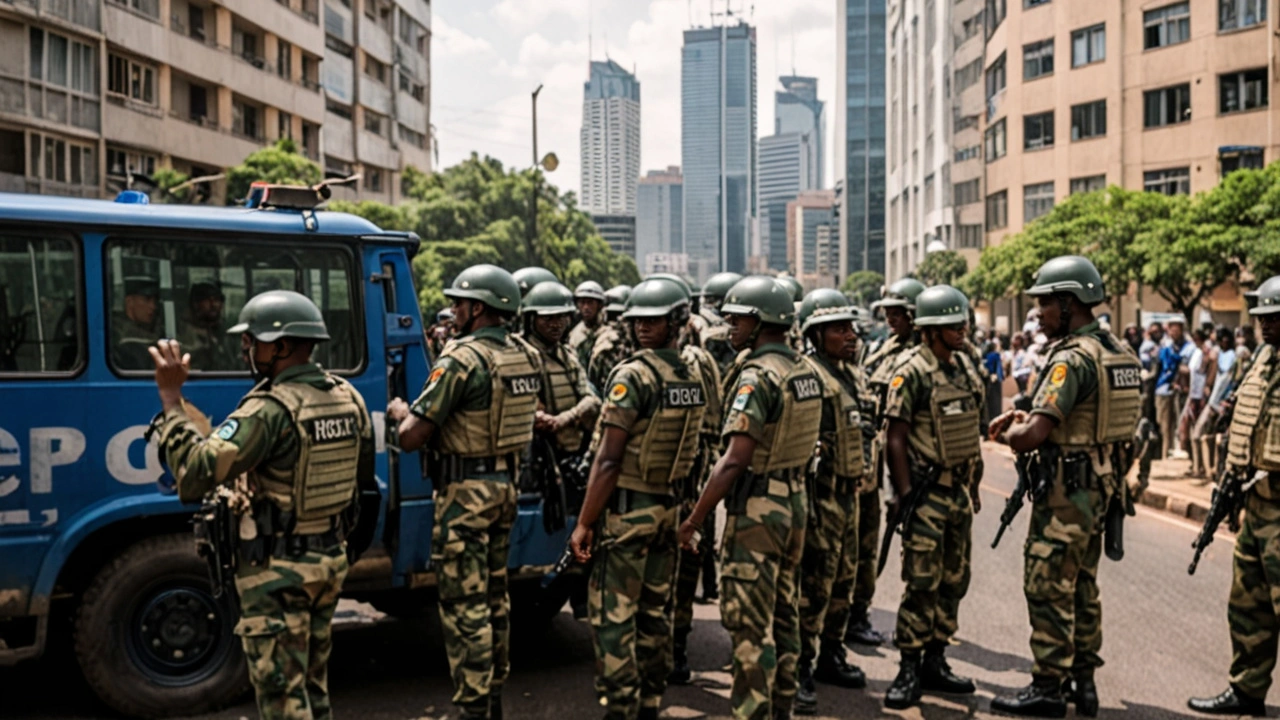Police Gear Up with Teargas as Protesters Flood Nairobi CBD
 Jul, 16 2024
Jul, 16 2024
Police Gear Up with Teargas as Protesters Flood Nairobi CBD
In the heart of Nairobi, on July 16, 2024, a scene of mounting tension unraveled as police officers prepared for the worst. The Central Business District (CBD) became a focal point of significant unrest as demonstrators converged, their grievances and demands echoing through the streets. Among the preparations, a notable activity was the refilling of teargas canisters by the police, a grim signal of the potential clashes that could ensue.
Parked conspicuously, a police lorry became the center of attention as officers systematically readied themselves. The visual of police gearing up served as an indication of the serious nature of the anticipated confrontations. These demonstrations in Nairobi are part of a broader wave of nationwide protests that have seen simmering discontent bubble to the surface, spreading across counties such as Turkana, Karatina, and Kisii, where reports of violence and confrontations continue to emerge.
The streets are alive with the energy of a population pushing back against perceived injustices and asserting their right to voice concerns. Protesters are not only demanding the immediate release of those detained during earlier demonstrations, but they are also voicing numerous complaints against the government. The calls for justice, accountability, and transparent governance seem to have reached a fever pitch.
Against this backdrop, the Interior Ministry has made it abundantly clear that while peaceful protests are a democratic right, any descent into chaotic behavior or criminal activities will be met with what they describe as 'reasonable force.' This statement underscores the fine line between maintaining order and respecting civil liberties—a balance that the authorities are striving to uphold amid the volatile situation.
The Root of the Discontent
To understand the magnitude of the unrest, one needs to delve into the root causes fueling these protests. Many citizens feel marginalized and disenfranchised, with a range of socioeconomic issues triggering the outcry. From rising living costs, corruption allegations, to perceived failures in public service delivery, the list of complaints is long and profound.
The pressure points are varied and interconnected. For instance, in Turkana, the grievances are heavily tied to resource management and development promises that locals feel have not been honored. In Karatina and Kisii, economic pressures and unemployment drive much of the discontent. The protests, therefore, are not mere isolated incidents but part of a larger tapestry of national dissatisfaction.
The Role of Social Media
Social media has played a pivotal role in galvanizing these protests. Platforms like Twitter and Facebook have become instrumental in organizing marches, disseminating information, and rallying support. The immediacy and reach of social media allow for real-time updates and mobilization, making it a double-edged sword for both the protesters and the authorities.
However, the virality of posts can also escalate tensions, with misinformation potentially spreading just as quickly as legitimate grievances. This dynamic requires a delicate approach from the authorities, who need to monitor the situation without infringing on free speech. The court of public opinion, partly shaped online, is a powerful force driving the momentum of the protests.
A Tense Standoff
The atmosphere in Nairobi's CBD is one of palpable tension. Businesses have shuttered their doors, public transport is on high alert, and pedestrians navigate the streets cautiously. The anticipation of possible confrontations has created an air of anxiety, with many fearing not just for their safety but for the stability of the city as a whole.
The protesters, meanwhile, appear undeterred. Their chanting and placards reveal a blend of hope and frustration. The message is clear: they demand change, and they are willing to face the teargas and batons to make their voices heard. The resilience of these demonstrators is both inspiring and concerning, hinting at a populace that feels it has little left to lose.
As night falls, the city holds its breath. The police, armed with their freshly refilled teargas canisters, stand ready. The demonstrators, emboldened by numbers and a sense of purpose, brace themselves for what may come. The tension between a government seeking order and a public demanding justice continues to build.
The Broader Implications
The situation in Nairobi is not just a local issue but a reflection of broader societal dynamics. The protests are a symptom of deeper systemic issues that authorities must address to prevent further unrest. This requires more than just tactical responses; it calls for strategic, long-term solutions that address the root causes of discontent.
Transparency, accountability, and effective governance are more than just political buzzwords—they are essential components of a stable society. The government's response to these protests will likely shape public perception and trust in the coming months and years. The call for dialogue and meaningful engagement with the protest leaders could be a step towards diffusing the immediate tension and laying the groundwork for sustainable peace.
In the coming days, the world watches Nairobi. The outcome of these protests, and how they are handled, will serve as a bellwether for the country's political and social landscape. Both the authorities and the protesters have critical roles to play in navigating this precarious situation towards a resolution that honors the principles of justice and democracy.
Annelise